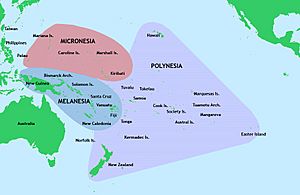Polynesian outlier facts for kids
Polynesian outliers are groups of people who live on islands outside the main area of Polynesia. This main area is often called the Polynesian Triangle. Even though these groups live in other parts of the Pacific Ocean, like Melanesia and Micronesia, they share the same Polynesian culture.
Scientists believe these islands were settled by brave Polynesian sailors. Most of these sailors came from places like Tonga, Samoa, and Tuvalu. They traveled long distances across the ocean to find new homes.
Contents
What are Polynesian Outliers?
The area we call "Polynesia" includes thousands of islands. These islands form a rough triangle on a map. The corners of this triangle are Hawaii, Easter Island, and New Zealand.
Outside this main Polynesian Triangle, there are about two dozen other islands. Most of them are small and far apart. The people living on these islands speak Polynesian languages. These islands are what we call Polynesian "outliers."
People in these outlier groups usually look similar to those in the main Polynesian Triangle. They often have brown skin and dark, wavy hair. They are also typically strong and well-built.
The fact that they all speak Polynesian languages tells us something important. It means their ancestors probably moved from the main Polynesian area not too long ago. However, their ways of life can be different.
- Some outlier groups settled close to Melanesian or Micronesian people. They might have learned things from their neighbors.
- Other outlier groups stayed separate. This could be because of where they lived or how they chose to live. These groups often seem more like the classic Polynesians.
Where are Polynesian Outliers?
Polynesian outlier cultures are found in five different countries in the Pacific Ocean:
- In the Federated States of Micronesia:
- Kapingamarangi
- Nukuoro
- In Papua New Guinea:
- Nuguria
- Nukumanu
- Takuu
- In the Solomon Islands:
- Ontong Java (also called Luangiua)
- Sikaiana (also known as the Stewart Islands)
- Vaeakau-Taumako (which includes the Duff Islands and Reef Islands)
- Rennell
- Bellona
- Anuta
- Tikopia
- In Vanuatu:
- Emae
- Mele (now called Ifira-Mele)
- Futuna-Aniwa (on Futuna Island and Aniwa Island)
- In New Caledonia:
- Ouvéa in the Loyalty Islands. People here speak the Fagauvea language.
What Languages Do They Speak?
The outlier groups in Micronesia, Papua New Guinea, and the northern Solomon Islands speak a type of Ellicean language. This group also includes the Tuvaluan language.
The groups further south in the Solomon Islands, Vanuatu, and New Caledonia speak a type of Futunic language. This group also includes the language of Wallis and Futuna.
Both Ellicean and Futunic languages are part of a bigger language family. This family is sometimes called the Samoan-Outlier language family. On some of these islands, the Polynesian outlier people might also speak the local Melanesian or Micronesian language.
Who Owns These Islands?
Two of the faraway Polynesian outlier islands have disagreements about who legally owns them:
- Kapingamarangi: This island is currently governed by the Federated States of Micronesia. However, Spain also claims it. Spain says it still owns the island because of a treaty from 1899.
- Sikaiana: This island, once known as the Stewart Islands, is now controlled by the Solomon Islands. But it was given to the Kingdom of Hawaii in 1856. When Hawaii became part of the United States, the U.S. also claimed Sikaiana. The Solomon Islands and the United States still disagree about who truly owns it.
Images for kids
-
Polynesia, Melanesia, and Micronesia in the Pacific Ocean
See also
 In Spanish: Islas periféricas polinesias para niños
In Spanish: Islas periféricas polinesias para niños




